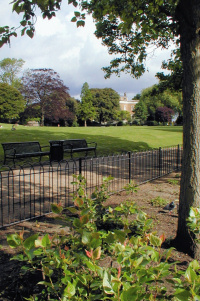Lee
Lee, Lewisham
An aggregation of several formerly separate settlements situated south of Blackheath and east of Lewisham

Lee was first mentioned in Domesday Book, with the same spelling as is used today, although there have been variants during the intervening period. The name means ‘woodland clearing’.
St Margaret’s church was built at the eastern end of Belmont Hill in the late Middle Ages and became the focus of the first hamlet in the parish. The next was in the Old Road area, where Pentland House was built in the mid-1680s. This is now a students’ hall of residence. The Manor House was built nearby around 1771 and was sold in 1796 to Sir Francis Baring, co-founder of the Baring Brothers banking house. The house later became a military college and is now a public library, with 14 acres of gardens and a lake behind.
Lee Green and the Tiger’s Head public house lay to the east. Farms and labourers’ cottages were the sole occupants of what was then the recently deforested area further south.
St Margaret’s was rebuilt in 1814 as Lee became a popular retreat for City merchants because of its ‘healthy and pleasant situation’.
From 1825 Lee New Town covered the gardens of Lee Place, around Lee Church Street and Boone Street, giving shelter to those who provided services for the wealthy residents here and in Blackheath Park. In response to the very rapid growth of the district a new St Margaret’s church was built across the road from its predecessor in 1841. The ruins of the old church remain.
Lee station opened in 1866, stimulating construction of housing for the middle classes to the south of the district. By the outbreak of the First World War, the whole of Lee was crowded with suburban dwellings. The jerry-built slums of Lee New Town were demolished in stages from the 1930s to the 1960s, aided by wartime bombing, and much of that area is now occupied by council housing.
Although its grandest houses have mostly gone, many Georgian and Victorian terraces survive and Lee has not been overly modernised except for the conversion of the larger houses into flats. Lee acquired a certain trendiness in the 1960s and a hint of this remains today.
Sir Edmond Halley, who gave his name to the comet, is buried in the graveyard of the old St Margaret’s church.
Stanley Unwin, publisher of The Lord of the Rings, lived in Handen Road.
The Man with the Twisted Lip lived in Lee, in the Sherlock Holmes story.
Postal districts: SE12 and SE13
Station: Southeastern Trains (zone 3)
